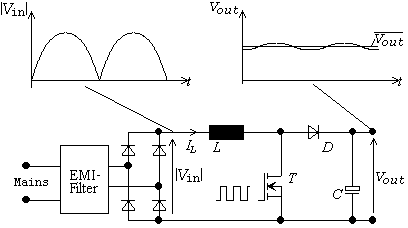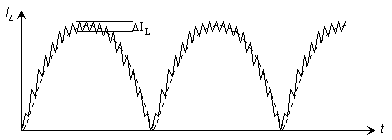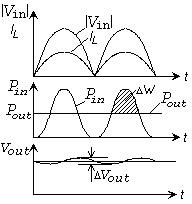
Illustration 1: Direct half-wave rectification:
The mains has high upper harmonic content
Power Factor Pre-regulator
| Harmonic- order n |
Input Power 75 to 600W Allowable maximum value of harmonic current per Watt (mA/W) / maximum (A) |
Input power > 600W maximum value of harmonic current (A) |
|---|---|---|
| 3 | 3.4 / 2.30 | 2.30 |
| 5 | 1.9 / 1.14 | 1.14 |
| 7 | 1.0 / 0.77 | 0.77 |
| 9 | 0.5 / 0.4 | 0.40 |
| 11 | 0.35 / 0.33 | 0.33 |

|
Illustration 1: Direct half-wave rectification: |

|
Illustration 2: Boost Converter as Power Factor Pre-regulator |

|
Illustration 3: The inductor current IL |
For the output power Pout this leads to:
![]()
and for the input power Pout(t):
![]()
The input power consists of a DC component
![]()
and an AC component
![]()
The DC component is equal to the output power Pout:
![]()
The PFC is taken to be loss free but actually an efficiency of 95% is realistic.
With this efficiency, the input power emerges to:
![]()
The r.m.s. value of the input current has its maximum when the input voltage is at its minimal value, i.e. minimal mains voltage:

This value will be required for the calculation of the inductor current later.

|
Illustration 4: |
The current ripple amounts to (see Boost Converter):

For L it follows that:

Usually, one chooses:

The maximum inductor current then amounts to:




![]()
This implies:
![]()
The magnitude of the voltage ripple ΔVout caused by ΔW, depends on the output voltage.
![]()

For the voltage ripple ΔVout it follows that:

as well as for the output capacitor C:

Usually, one chooses ΔVout = 5% of Vout = 380V. This results in a voltage ripple of +/- 10V. For 50/60Hz - mains it follows that the output capacitor should be: C = 0.5µF/W